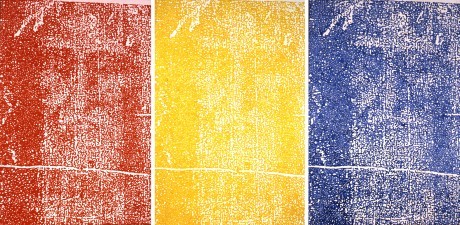Modern Icons
13 Apr - 31 Oct 2014
MODERN ICONS
Painting from the Ludwig Collection
13 April 2014 until further notice
Curator: Benjamin Dodenhoff
They are everywhere – advertising icons, style icons, icons of pop music and elite sport, icons of revolution and resistance. Journalists speak of media icons when a photo leaves a lasting impression and inscribes itself in the collective memory. As for the classical religious icon in this context, it is above all one thing: the origin of modern painting. The clarity of the manner of representation, the focused reduction on what is essential, the stylization and repetition of motifs – the strict canon of forms evident in historical images of saints, transmitted by a tradition stretching back centuries, continues to resonate in contemporary art.
Drawing on paintings from the Ludwig Collection, the exhibition Modern Icons shows how diversely artists down to the present day have approached and reworked the idea of the icon. Old idols are revered, transformed, or destroyed. At the same time, new, modern icons are created.
In three color variations Jiří Georg Dokoupil brings Christ’s holy face to giant canvasses, showing how the techniques of modern painting can actually intensify the aura of the traditional images of saints (Shroud of Turin, 1986). For his photographic-like portrait Richard (1969), Chuck Close chooses the same strict frontal compositional schema. Just the transformation into painting already seems to elevate the portrayed figure out of the triviality of the photographic model, enhancing the iconic aspect. In Franz Gertsch’s Medici (1971) the five young men in jeans, jumpers and leather jackets, casually leaning against a building-site barrier, would almost be an everyday sight if they did not face us, painted with the meticulous precision of hyperrealism, from a vast canvas measuring four by six meters.
Pop culture produces its own icons: stars, comic heroes, athletes. And the mass media has quickly created its own canon of forms for its idols, like the peroxide-blonde hair of female film stars, which Roy Lichtenstein takes up in his comic-like paintings of the 1960s. Motifs and patterns are repeated and invoked so often that they turn into clichés. It is at once irritating and unmasking when the painter takes up the stereotypes circulating in the mass media to present Fidel Castro as an advertising figure for an American perfume (José Angel Toirac, Eternity, 1996).
Above all Communist regimes utilize the impact generated by religious portrayals. Dissident artists from Cuba, Eastern Europe, or China find it extremely difficult to accept the sight of these “modern saints”. They strike back and launch an aesthetic counterattack: applying just the slightest changes, they are able to tip the exaggerated ceremonious gestures of state art into something obviously ironic, making these gestures ridiculous (Eric Bulatov, Sunrise or Sunset, 1989).
Painting from the Ludwig Collection
13 April 2014 until further notice
Curator: Benjamin Dodenhoff
They are everywhere – advertising icons, style icons, icons of pop music and elite sport, icons of revolution and resistance. Journalists speak of media icons when a photo leaves a lasting impression and inscribes itself in the collective memory. As for the classical religious icon in this context, it is above all one thing: the origin of modern painting. The clarity of the manner of representation, the focused reduction on what is essential, the stylization and repetition of motifs – the strict canon of forms evident in historical images of saints, transmitted by a tradition stretching back centuries, continues to resonate in contemporary art.
Drawing on paintings from the Ludwig Collection, the exhibition Modern Icons shows how diversely artists down to the present day have approached and reworked the idea of the icon. Old idols are revered, transformed, or destroyed. At the same time, new, modern icons are created.
In three color variations Jiří Georg Dokoupil brings Christ’s holy face to giant canvasses, showing how the techniques of modern painting can actually intensify the aura of the traditional images of saints (Shroud of Turin, 1986). For his photographic-like portrait Richard (1969), Chuck Close chooses the same strict frontal compositional schema. Just the transformation into painting already seems to elevate the portrayed figure out of the triviality of the photographic model, enhancing the iconic aspect. In Franz Gertsch’s Medici (1971) the five young men in jeans, jumpers and leather jackets, casually leaning against a building-site barrier, would almost be an everyday sight if they did not face us, painted with the meticulous precision of hyperrealism, from a vast canvas measuring four by six meters.
Pop culture produces its own icons: stars, comic heroes, athletes. And the mass media has quickly created its own canon of forms for its idols, like the peroxide-blonde hair of female film stars, which Roy Lichtenstein takes up in his comic-like paintings of the 1960s. Motifs and patterns are repeated and invoked so often that they turn into clichés. It is at once irritating and unmasking when the painter takes up the stereotypes circulating in the mass media to present Fidel Castro as an advertising figure for an American perfume (José Angel Toirac, Eternity, 1996).
Above all Communist regimes utilize the impact generated by religious portrayals. Dissident artists from Cuba, Eastern Europe, or China find it extremely difficult to accept the sight of these “modern saints”. They strike back and launch an aesthetic counterattack: applying just the slightest changes, they are able to tip the exaggerated ceremonious gestures of state art into something obviously ironic, making these gestures ridiculous (Eric Bulatov, Sunrise or Sunset, 1989).

